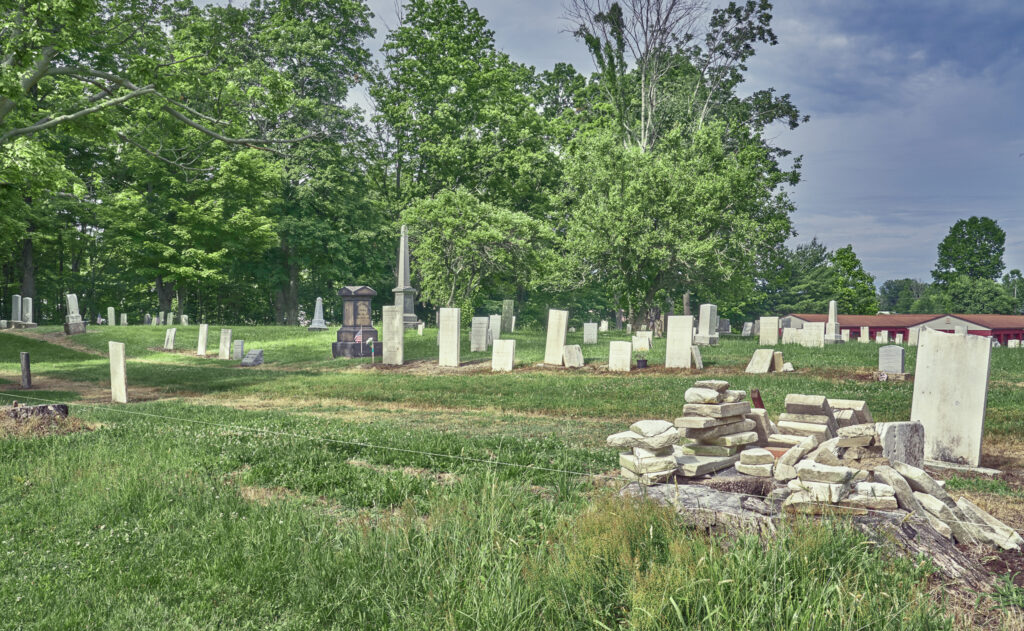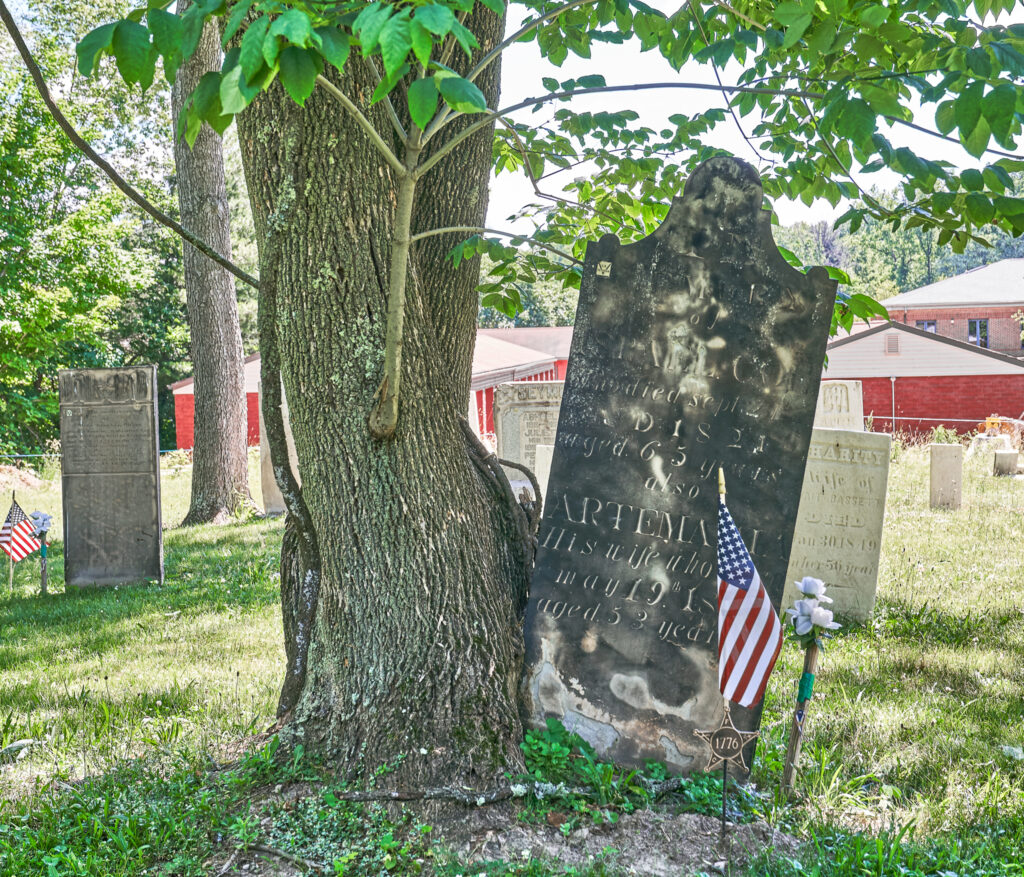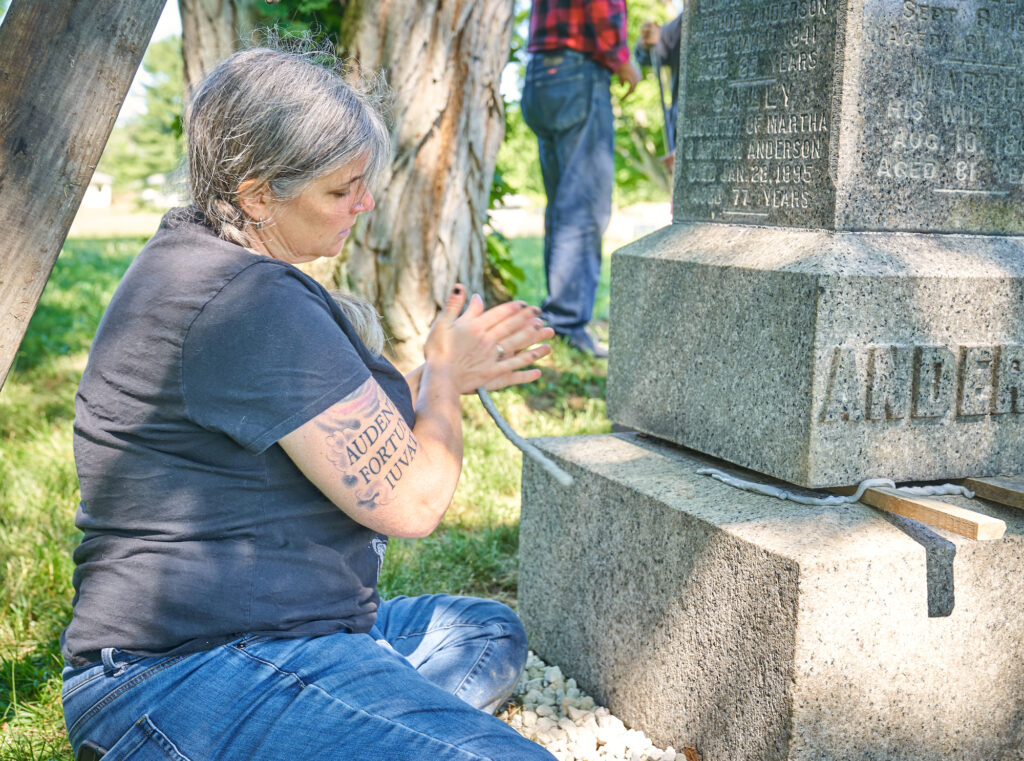Benjamin Franklin once said, “Show me your cemeteries and I will tell you what kind of people you have.” By this he meant that if people make an effort to honor the deceased by taking care of local cemeteries, then they are an honorable community.
At lesser-known cemeteries across the United States and Portage County, those words have largely gone ignored as erosion grinds away tombstones and nature reclaims the grounds. But one group in Rootstown is going out of its way to bring new life into an old burial ground.
The Rootstown Township Trustees and the Rootstown Old Cemetery Committee sponsored a two-day cemetery workshop June 17-18, kicking off an ongoing tombstone marker process for “The Old Cemetery” on Tallmadge Road.
The workshop featured cemetery restoration specialist Tim Foor, from Ashley, Ohio, who has helped townships restore cemeteries in locations as far away as Charleston, South Carolina.
During the workshop, Foor educated trustees, committee members and other participants about the process of tombstone restoration. He also shared his knowledge regarding the history of old cemeteries and gravestones and the vivid record of community history that they hold. More than 20 participants attended the event over the course of both days.
Restoring the grave markers at what was formerly known as “Ye Olde Cemetery” has been in the plans for a while, Rootstown Historical Society Trustee Don Boyle said, but acquiring the resources to undertake such a project has been a challenge.
Much of the funding came from donations from the community and out-of-pocket contributions from committee members. Boyle said the improvements that took place during the workshop exceeded his expectations for the project.
“If we were to just hire Tim [Foor] to come in and do it, it would have cost us more than the two-day workshop,” Boyle said. “So to know how many stones we fixed, how many stones we just straightened, and then the big one [large obelisk], just to know that we got that done was just totally amazing.”

“Ye Olde Cemetery” is a one-acre burial ground that was donated to Rootstown by the Reed family in the early 1800s. Historic censuses show that most of the people who died in Rootstown between 1810 and 1820 were buried at the cemetery. Its first eternal guest arrived in 1809, when Nathan Chapman died at the age of 50, and being that there were few roads at the time, he was carried to his plot by hand on a small trail.
“Tallmadge Road wasn’t even there,” Boyle said. “A couple guys carried him down what was considered a horse path, carried him from his home up to be buried there, and that was probably at least a mile from up where the Chapmans lived to where the Reeds were. Times were a lot different: You didn’t have cars, you didn’t have grocery stores, you didn’t have electricity, you didn’t have so many of the things that we just take for granted today. So, you gotta just kinda admire the folks who were the pioneers, the frontiersmen.”
Chapman’s gravestone is currently undergoing off-site repair but will soon be back at the cemetery to memorialize the burial ground’s first arrival.
Boyle said the cemetery has been largely neglected, due in part to the fact that many of the family members of the deceased who are buried there have left the area, making them unavailable to maintain the plots. Many of the unkept gravestones have fallen over, and many of the ones that have yet to fall are severely leaning and need to be trued.
John Fassnacht, president of the Rootstown Historical Society, said some gravestones are likely buried beneath the ground. He is currently seeking funds to purchase ground-penetrating radar [GPR] equipment to locate gravestones that may be embedded in the ground and to locate unmarked graves that once had wooden crosses that have since rotted away.

Foor said prior to the introduction of railways, tombstones were somewhat of a luxury item.
“Up to a certain period, we didn’t have a lot of stone carvers in the United States,” Foor said. “And there weren’t a lot of quarries as well. And the only marble quarries there were, were up in Vermont, and they didn’t really get into those until around 1830, 1840. So, prior to that, if you got marble in a headstone, chances are it came from over in Italy somewhere, and it probably rode across the ocean on the bottom of a ship as a ballast to keep the ship upright when it was going through the ocean and facing the wind and waves and things of that nature.
“Then, of course, once it got here, your railways came in around 1850 or so, so prior to that, it would have been coming down a canal or by wagon somewhere. So it was a lot of horse-drawn wagons and canal trips. There were primitive stones, you had a lot of wooden crosses, things that didn’t last.”
For restorers who have yet to acquire GPR, one technique that can help locate graves without stones is knowing which side of the gravestones the plots are on in a given row; this information is particularly useful when probing for graves with a blunt six-foot rod. For many old Christian cemeteries, headstones often face east.
“A lot of your older cemeteries would be [run] in a traditional fashion,” Foor said. “It would be more, I guess, a Christian background, so all the heads [of the deceased] would traditionally be to the west, so when they sat up in the grave they would be facing the direction [east] that Jesus would come from in the Rapture. So when you go into some of those old cemeteries, that’s kind of what you’re looking for, you know, are the headstones in the right place? Does it seem like the graves are in the right location? Of course, sometimes you go into a cemetery and people have worked in there and they have moved things around and you really have no idea where anything’s at at that point, so you’re basically just trying to make what’s there look good.”
Only a handful of the grave markers at the Rootstown cemetery were made with longevity in mind; those are typically made of granite, one of the most durable types of gravestones. But most of the markers at “The Old Cemetery” are made from softer stone that needs more care.
Foor said the grave markers that require the most repair are the ones made of marble, sandstone, brownstone and slate. It’s the softer gravestones that break into pieces, develop cracks and crags, and become weathered and difficult to read. When a weathered gravestone is unreadable, it can be canted at an angle toward a light source, which can sometimes reveal inscriptions, Foor said. But sometimes it takes computer software to decipher lettering, such as PicMonkey or Photoshop, if you’re savvy enough to use it.

Depending upon the damage, revamping old tombstones can range anywhere from cleaning weathered stone with D/2 biological solution, leveling bases, hoisting fallen gravestones and fixing the ones that have broken into pieces to pouring slotted concrete bases for slab tombstones.
In the past, less-than-desirable techniques were often used to repair tombstones, which could lead to further damage, but restorers now have a do-no-harm policy that increases the life of repaired gravestones. For instance, nowadays restorers use an extremely durable epoxy to glue a broken slabstone marker back together, whereas in the past some slabstones had holes bored in them so they could be joined with metal straps. Foor said drilling into a marker can cause unwanted cracking that is hard to fix.
The highlight of the workshop was leveling a nearly 12-foot obelisk monument that historical society members said could cause serious injury or death if the leaning pyramid-like monument were to fall over.
Foor said lifting an obelisk of that size is tricky business because of its weight. This particular one weighed 600 pounds or more.
A chain hoist hanging from a two-by-six wood tripod was used to remove the obelisk from its base, so that the base could be leveled without the risk of the obelisk falling in the process. The low side of the base was then raised with dual fulcrum bars, then gravel was shoveled beneath it to true it up. Before the obelisk was reunited with its base, lead spacers were placed between the two, creating a space that was later chinked with putty to keep water from seeping in and freezing. The project was a success, and the monument is back to its former glory.

Attending both days of the workshop was veteran cemetery conservationist Wendy Everett from Gals in the Graveyard, a Columbus business specializing in gravestone cleaning and repair, cemetery conservation and consultation, as well as historical research and design. Everett has attended many workshops and classes regarding cemetery restoration and said that “The Old Cemetery” workshop had some of the most impressive participants she has seen.
“Out of all the workshops I’ve been to, this one had the most enthusiastic participants,” Everett said. “A lot of the workshops, people kinda stand back and don’t wanna get their hands on things. But these guys were jumping in and just getting right to work, taking that information and just immediately going out and working.”
During the workshop, Everett said she took several pictures of the event for archival purposes. The images can be viewed at her Facebook page at https://www.facebook.com/gravegals/.
The Rootstown Historical Society has plans to continue the restoration of “The Old Cemetery” as well as Homeland Cemetery across the street. Boyle said the historical society may inquire about recruiting the Eagle Scouts or the local high school football team to help with the project and is determined to get it done.
If you’d like to volunteer to help restore “The Old Cemetery” or Homeland Cemetery, contact John Fassnacht at 330-325-7596.

